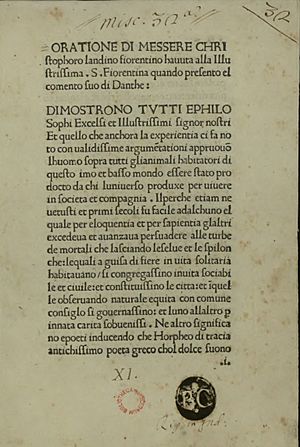Cristoforo Landino facts for kids
Cristoforo Landino (born in 1424 in Pratovecchio, Florence, and died on September 24, 1498, in Borgo alla Collina) was an important Italian humanist. He played a big part in the Florentine Renaissance, a time of great art and learning.
Life Story
Cristoforo Landino was born in Florence in 1424. His family came from an area called Casentino. He studied law and Greek. Even though his father wanted him to be a lawyer, Cristoforo chose to study philosophy instead. He could do this because Piero di Cosimo de' Medici, a powerful person, supported him. Landino's wife, Lucrezia, was from the important Alberti family.
In 1458, Landino became a professor of writing and poetry at the Florentine Studio. At first, his students wanted a more famous teacher. But Landino stayed and became a very important part of Florence's cultural and intellectual life.
Landino was also a member of the Platonic Academy in Florence. This group was started by Marsilio Ficino. Landino taught Lorenzo de' Medici and his brother Giuliano, who were very influential leaders. He also worked for the government. He was the chancellor (a high official) for the Guelf party in 1467. Later, he wrote public letters for the Signoria, which was Florence's ruling council.
Landino passed away in 1498 at a villa in Borgo alla Collina. The Medici family had given him this villa as a gift.
His Writings
Landino wrote many books and essays. He strongly believed in using the everyday Italian language for writing, not just Latin.
He wrote three important philosophical dialogues. These were like conversations between different people discussing ideas. They were called De anima (from 1453), De vera nobilitate (from 1469), and Disputationes Camaldulenses (around 1474). In the Disputationes, different thinkers talked about whether an active life or a quiet, thoughtful life was better.
Landino also published three books of Latin poems under the name "Xandra." He dedicated these poems to Piero de' Medici in 1458. He also wrote many letters and speeches. These were published in Italian in Venice in 1561, long after he died.
Landino's commentaries were very important for the Renaissance. He wrote detailed notes and explanations for famous works. These included the Aeneid (in 1478) and The Divine Comedy (in 1481). To help promote Italian, Landino gave lectures on Petrarch, a famous Italian poet. He also translated and published Pliny's Historia naturalis (in 1476). He also translated Giovanni Simonetta's Latin book about the life of Francesco Sforza (in 1490). One of his students was the historian Andrea Cambini.
See also
 In Spanish: Cristoforo Landino para niños
In Spanish: Cristoforo Landino para niños





